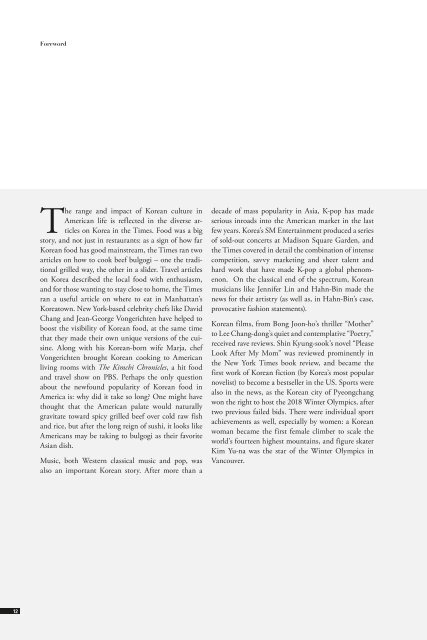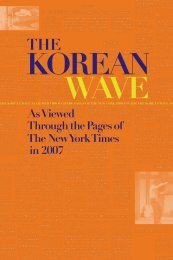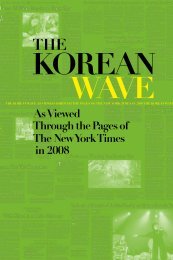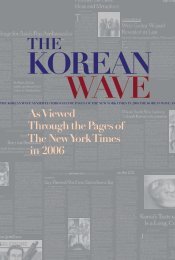The Korean Wave 2010-2011 - Korean Cultural Service
The Korean Wave 2010-2011 - Korean Cultural Service
The Korean Wave 2010-2011 - Korean Cultural Service
Create successful ePaper yourself
Turn your PDF publications into a flip-book with our unique Google optimized e-Paper software.
Foreword<strong>The</strong> <strong>Korean</strong> <strong>Wave</strong> is Here to Stay<strong>The</strong> range and impact of <strong>Korean</strong> culture inAmerican life is reflected in the diverse articleson Korea in the Times. Food was a bigstory, and not just in restaurants: as a sign of how far<strong>Korean</strong> food has good mainstream, the Times ran twoarticles on how to cook beef bulgogi – one the traditionalgrilled way, the other in a slider. Travel articleson Korea described the local food with enthusiasm,and for those wanting to stay close to home, the Timesran a useful article on where to eat in Manhattan’sKoreatown. New York-based celebrity chefs like DavidChang and Jean-George Vongerichten have helped toboost the visibility of <strong>Korean</strong> food, at the same timethat they made their own unique versions of the cuisine.Along with his <strong>Korean</strong>-born wife Marja, chefVongerichten brought <strong>Korean</strong> cooking to Americanliving rooms with <strong>The</strong> Kimchi Chronicles, a hit foodand travel show on PBS. Perhaps the only questionabout the newfound popularity of <strong>Korean</strong> food inAmerica is: why did it take so long? One might havethought that the American palate would naturallygravitate toward spicy grilled beef over cold raw fishand rice, but after the long reign of sushi, it looks likeAmericans may be taking to bulgogi as their favoriteAsian dish.Music, both Western classical music and pop, wasalso an important <strong>Korean</strong> story. After more than adecade of mass popularity in Asia, K-pop has madeserious inroads into the American market in the lastfew years. Korea’s SM Entertainment produced a seriesof sold-out concerts at Madison Square Garden, andthe Times covered in detail the combination of intensecompetition, savvy marketing and sheer talent andhard work that have made K-pop a global phenomenon.On the classical end of the spectrum, <strong>Korean</strong>musicians like Jennifer Lin and Hahn-Bin made thenews for their artistry (as well as, in Hahn-Bin’s case,provocative fashion statements).<strong>Korean</strong> films, from Bong Joon-ho’s thriller “Mother”to Lee Chang-dong’s quiet and contemplative “Poetry,”received rave reviews. Shin Kyung-sook’s novel “PleaseLook After My Mom” was reviewed prominently inthe New York Times book review, and became thefirst work of <strong>Korean</strong> fiction (by Korea’s most popularnovelist) to become a bestseller in the US. Sports werealso in the news, as the <strong>Korean</strong> city of Pyeongchangwon the right to host the 2018 Winter Olympics, aftertwo previous failed bids. <strong>The</strong>re were individual sportachievements as well, especially by women: a <strong>Korean</strong>woman became the first female climber to scale theworld’s fourteen highest mountains, and figure skaterKim Yu-na was the star of the Winter Olympics inVancouver.<strong>Korean</strong> clothing, art, architecture and design havebeen receiving some belated appreciation in the West,as an article on the art of the hanbok showed. <strong>Korean</strong>influencedclothing design even reached the WhiteHouse, when First Lady Michelle Obama wore a dressby the <strong>Korean</strong>-American designer Doo-ri Chung fora state dinner with President Lee Myung-bak, a dinnerwhere the <strong>Korean</strong>-American sisters the Ahn Trioperformed. <strong>The</strong> revival and modernization in contemporaryKorea of the hanok, or traditional <strong>Korean</strong>house, made the news as well. Back in New York,the Metropolitan Museum of Art held a beautifulexhibition of traditional <strong>Korean</strong> ceramics, and LeeUfan’s installation “Marking Infinity” occupied theGuggenheim Museum.Korea’s well-known obsession with children’s education,and <strong>Korean</strong>s’ ambitious innovations in the educationfield, gained some attention with articles onJeju Island’s planned “Global Education City” andthe “Engkey” English-teaching robot invented at theKorea Institute of Science and Technology. <strong>The</strong> Timestravel section feature a guide to “36 Hours in Seoul,”covering restaurants, museums, shopping, and eventhe jjimjilbang or bathhouse.Korea is becoming an increasingly familiar place forAmericans, but Korea is no longer a place “over there,”exotic and strange. It is becoming increasingly part ofthe American cultural fabric, a place as familiar to thereaders of the Times as the restaurant down the block.At this point, it may no longer be useful to describe the<strong>Korean</strong> cultural impact as a “wave.” <strong>Korean</strong> culture isnow a major tributary of the American mainstream.1213





